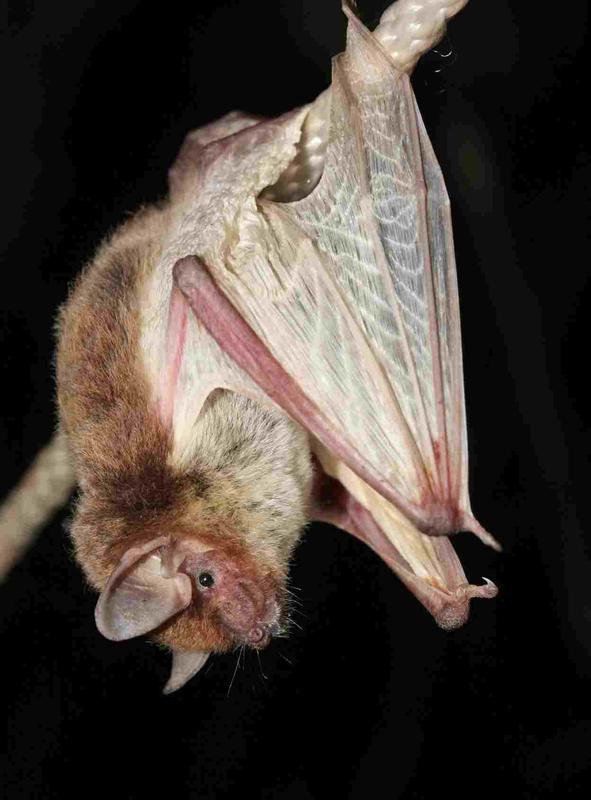An Attractive new Bat Species from West Africa

Isabelline White-winged Serotine bat (Neoromicia isabella) from the Simandou-Mountains in Guinea (Photo: © Jan Decher 2008)
During research on the small mammal diversity in the West African country of Guinea, mammalogist Dr. Jan Decher from the Zoological Research Museum Alexander Koenig – Leibniz Institute for Animal Biodiversityin Bonn and his team discovered an attractive small bat, which will have the scientific name Neoromicia isabella in future, or Isabelline White-winged Serotine in English.
The tiny bat has a body length of 4-5 cm and weighs about 5 grams. Flight membranes, tail membrane and the fur of the belly are colored white; the ears, lips and feet are also almost white. In contrast, the hairs on the back are isabella-coloured, that is light orange-brown.
This unique contrasting colouration differs from all other species occurring in West Africa. Genetic studies carried out in the Centre for Molecular Biodiversity at Museum Koenig support its status as a new species.
Between 2008 and 2012 researcher from Germany, The United States and Swaziland discovered the Isabelline White-winged Serotine during environmental impact assessments in the Simandou and Nimba Mountains of southeastern Guinea.
The species occurs in relatively undisturbed rainforest areas that are part of iron ore mining concessions awarded to international mining companies. The biological surveys were designed to assess which rare animal and plant species occur on the mountains and provide data for planning the mining operation as environmentally sustainable as possible.
In the Simandou Mountains 35 bat species were found. Species richness estimations showed that up to 45 bat species may occur there. Thus, the Simandou Mountains are one of the regions with the most diverse bat fauna in Africa.
Contact:
Dr. Jan Decher
Zoologisches Forschungsmuseum Alexander Koenig
Adenauerallee 160, D-53113 Bonn, Germany
Phone: +49 228 9122262
E-mail: j.decher@zfmk.de
Source:
Decher, J., Hoffmann, A., Schaer, J., Norris, R.W., Kadjo, B., Astrin, J., Monadjem, A., Hutterer, R. 2016. Bat diversity in the Simandou Mountain Range of Guinea, with the description of a new white-winged vespertilionid. Acta Chiropterologica 17(2): 255-282 (for 2015)
doi: http://www.bioone.org/doi/full/10.3161/15081109ACC2015.17.2.003
The Zoological Research Museum Alexander Koenig (ZFMK) and Leibniz Institute for Animal Biodiversity is one of the largest natural-history-research museums in Germany. The museum has earned its reputation as a leader in the documentation, research, and interpretation of biodiversity.
The Leibniz Association is a network of 89 scientifically, legally and economically independent research institutes and scientific service facilities. Leibniz Institutes perform strategic- and thematically-oriented research and offer scientific service of national significance while striving to find scientific solutions for major social challenges.
http://www.bioone.org/doi/full/10.3161/15081109ACC2015.17.2.003
Media Contact
More Information:
http://www.zfmk.deAll latest news from the category: Life Sciences and Chemistry
Articles and reports from the Life Sciences and chemistry area deal with applied and basic research into modern biology, chemistry and human medicine.
Valuable information can be found on a range of life sciences fields including bacteriology, biochemistry, bionics, bioinformatics, biophysics, biotechnology, genetics, geobotany, human biology, marine biology, microbiology, molecular biology, cellular biology, zoology, bioinorganic chemistry, microchemistry and environmental chemistry.
Newest articles

Sea slugs inspire highly stretchable biomedical sensor
USC Viterbi School of Engineering researcher Hangbo Zhao presents findings on highly stretchable and customizable microneedles for application in fields including neuroscience, tissue engineering, and wearable bioelectronics. The revolution in…

Twisting and binding matter waves with photons in a cavity
Precisely measuring the energy states of individual atoms has been a historical challenge for physicists due to atomic recoil. When an atom interacts with a photon, the atom “recoils” in…

Nanotubes, nanoparticles, and antibodies detect tiny amounts of fentanyl
New sensor is six orders of magnitude more sensitive than the next best thing. A research team at Pitt led by Alexander Star, a chemistry professor in the Kenneth P. Dietrich…





















